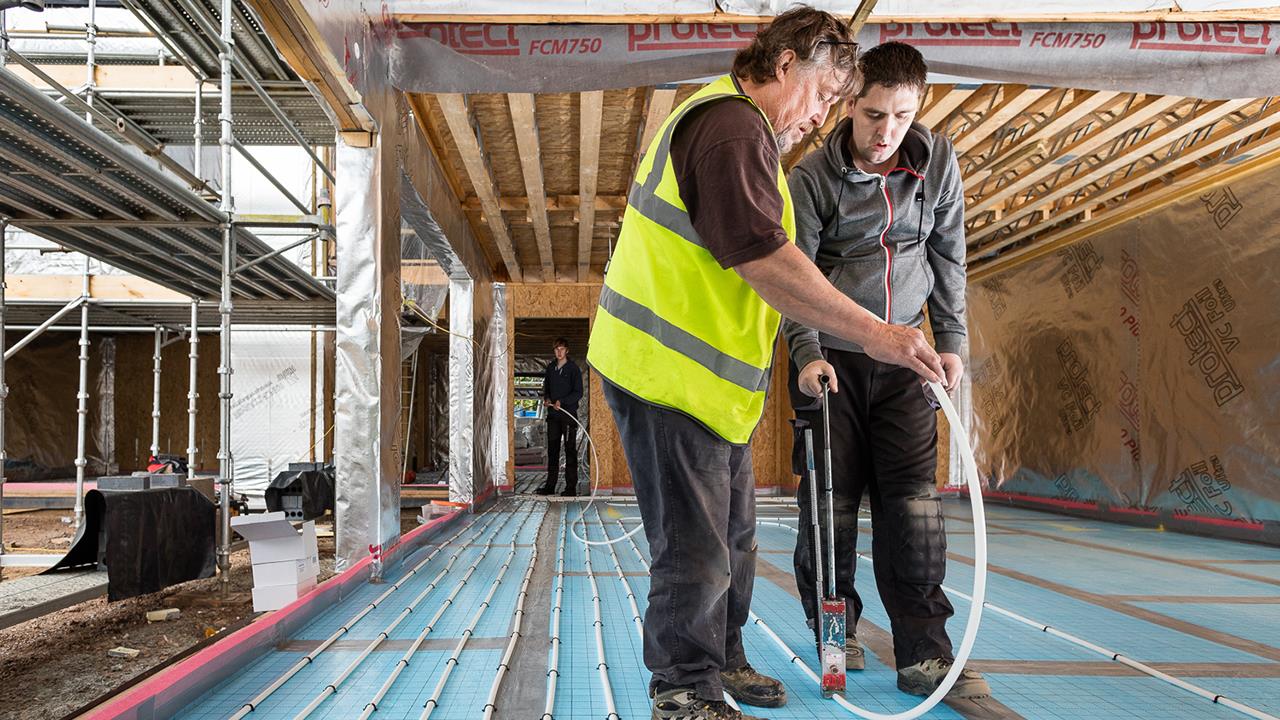

Carson Remmington, Business Development Manager at Ambiente, provides advice on how to avoid common pitfalls when specifying and installing underfloor heating (UFH) for both retrofit and newbuild installations.
Retrofit requirements
With retrofit projects, you’re working with what you’ve got and it’s likely that, with older properties, the building has not been designed with UFH in mind. As such, the major factor to consider is floor levels and how other elements within the room may be affected by the floor build up.
One situation may be if a customer has already made plans for the finishing touches which have been specified using the floor height, such as skirting board and kitchen worktop finishing levels.
As retrofit UFH is laid on top of the existing floor, the key is to ensure the lowest possible build up, while still maintaining sufficient output to meet the property’s heat loss. Preparation is paramount as the retrofit UFH panels predominantly run within pre-grooved channels. Always carefully plan and lay the panels efficiently to ensuring the pipework runs with access to all areas and is able to return to the manifold to complete the loop.
System specification
It goes without saying that reviewing the existing, or proposed, heating source is critical to ensure it is sufficient for the area that you are trying to heat. But at this early stage, there are some other factors to take into consideration, as each element will affect the way the system is designed and how it will perform.
When it comes to system design, in addition to planning the area/s to be heated, it’s important to understand the floor construction and proposed floor covering.
Seamless sequencing
Delays and additional expense can occur when UFH isn’t planned into the build process correctly, so keeping a line of communication open with other trades is advantageous. While there is no right or wrong way to sequence UFH, as it can be easily accommodated, sequencing is important when it comes to managing timings, addressing contractual arrangements, and also working seamlessly around supply and logistics.
Typically, there are two stages when UFH is sequenced in screed, either before or after housing structures are built, with both options suitable for and widely used to incorporate the product within a residential newbuild.
With either option, forward planning allows all involved to accommodate any potential changes to heated or unheated areas and also work out chronological sequencing of the screeder to limit UFH pipes being exposed for long periods unnecessarily.
Efficiency education
Control is a key element of UFH, as it can make all the difference to the efficiency of the system. However, it’s often one area homeowners are left to understand post-installation and may not make the best use of, or feel it isn’t what they expected, without some professional guidance.
The main difference to provide guidance on in terms of the heating behaviour is the length of the response time – radiators can be warm in a matter of minutes, whereas UFH within a screed floor can take up to an hour to warm up.
In contrast to scheduling radiator systems to switch on/off throughout the day and night, once up to temperature UFH systems should be left running constantly at a comfortable level. Getting customers aquatinted with the controls ensures they are maximising the benefits and potentially upselling smart controls, which benefits both parties.
Don’t fit and forget
While servicing heat sources is seen as an annual ‘to do’ for consumers, it’s also recommended that UFH is checked regularly too, which is beneficial for both you and your customer. Being proactive like this is much better than waiting for a fault to occur, and then having to reactively resolve the issue. In most cases, this can be more expensive for the customer and lead to the heating not working as effectively, or not at all, until it is fixed.
Although UFH is largely maintenance-free, an annual service is highly recommended. Servicing provides an opportunity to regularly maintain the system, ensuring it’s running smoothly and efficiently. An annual touch point with homeowners is also a great opportunity to offer any additional tips to help them maximise every benefit of the system.
If you'd like to keep up-to-date with the latest developments in the heating and plumbing industry, why not subscribe to our weekly newsletters? Just click the button below and you can ensure all the latest industry news and new product information lands in your inbox every week.